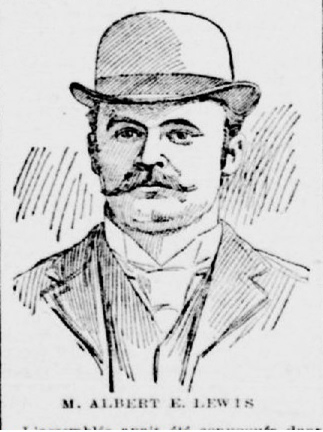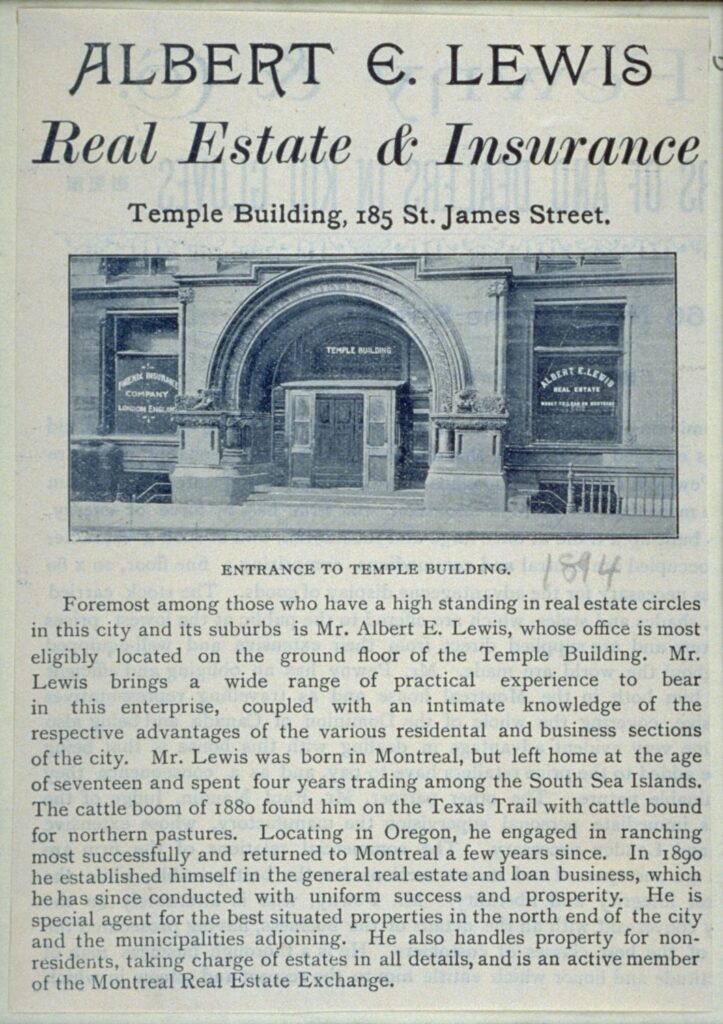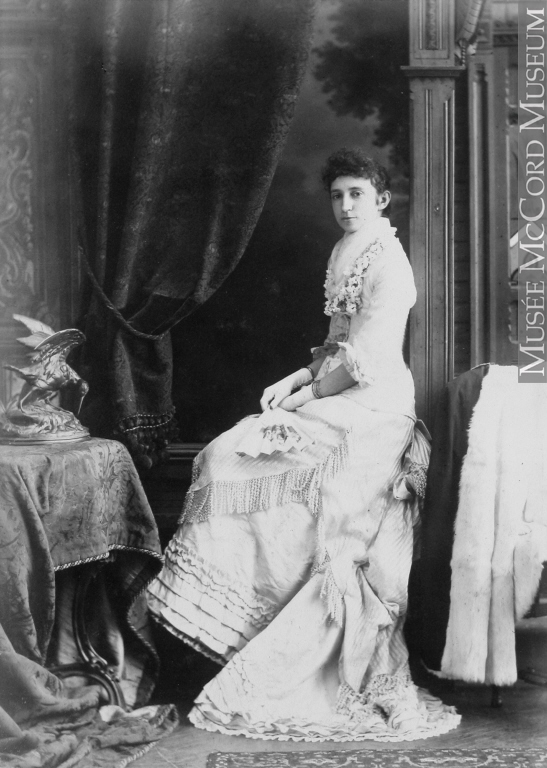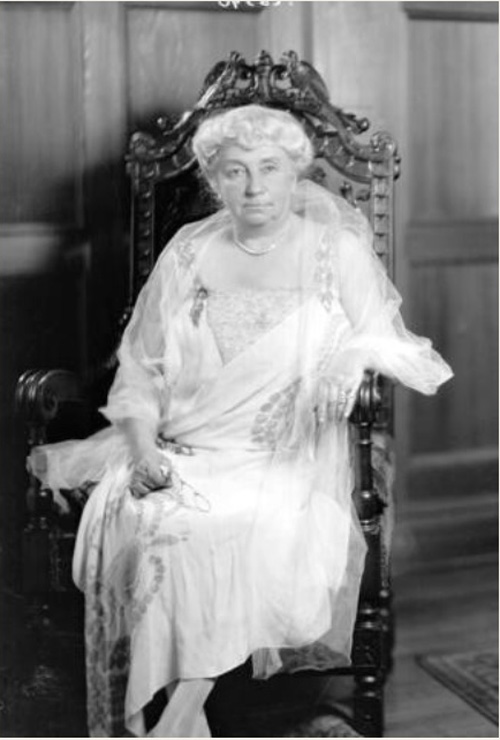My great-grandparents were quiet, respectable people so when their brother-in-law landed on the front pages of Montreal newspapers for all the wrong reasons, they must have been horrified.
The newsmaker was real estate developer Albert Edward Lewis,1 husband of Helen Frances Bagg. On November 22, 1897, a headline in The Gazette ran, “A PECULIAR CASE. Mysterious Disappearance of A.E. Lewis. …. LARGE REWARD IS OFFERED. Suspicious Characters Seen Loitering Near his Residence on Saturday Evening Shortly Before His Disappearance.”

For several days, both English and French-language newspapers reported on the mystery. Evidence of a struggle was spotted near the last place he had been seen, and the police dragged nearby quarries for his body. His wife was afraid he had been murdered. Brother-in-law R. Stanley Bagg (my great-grandfather), who was also a business associate, described Lewis as a gentle man who had no enemies — and an excellent fighter who could take care of himself.
Two days later, the tone of the articles changed. La Minerve reported that Lewis had frequently been seen in the company of a pretty young woman. The newspapers now said he had left Montreal of his own accord and was in New York, en route for southern Africa. It became clear that Lewis had staged the mysterious circumstances surrounding his flight.
On November 27, a brief item in The Gazette reported that R. Stanley Bagg had taken out a seizure before judgement against Lewis for $10,000. In 1895, Bagg had sold property to Lewis for $10,000, and Lewis was due to pay $300 in interest a few days after his disappearance. In the intervening two years, the property Lewis had purchased with the intention of selling as building lots had lost value, partly because the privately owned tramway that provided transportation to the area was in serious financial trouble and unable to offer reliable service. Eventually Bagg recovered some of the money that Lewis owed when 50 building lots that Lewis owned were seized and sold at a sheriff’s auction.2
Six years earlier, Lewis’s Montreal real estate business had promised to be very successful, partly because of his links to the Bagg family. They had inherited several adjoining farm properties along what is now Saint Laurent Boulevard. R. Stanley Bagg was selling the lots nearest the city center and, a little further afield, the Montreal Freehold Company had purchased a large piece of land from the Baggs with the intention of developing it. Lewis was the sole real estate agent for both parties for the best lots: those facing St. Lawrence Street.3
R. Stanley Bagg must have trusted his brother-in-law to give him this advantage, so what was Albert Edward Lewis’s background? The Lewis family had deep roots in Flintshire, Wales. John Lewis (1820-1891) immigrated to Montreal in the mid-1800s and worked as a bureaucrat at the city’s busy port. He married Matilda Snowdon (1827-1902) and the couple had four children: Lansing, Eleanor Ida, Albert Edward and Lily.4

Lewis’s business promotional material5 says he left home at age 17 and “spent four years trading in the South Sea Islands. The cattle boom of 1880 found him on the Texas Trail with cattle bound for northern pastures. Locating in Oregon, he engaged in ranching most successfully and returned to Montreal a few years since.” He went into the general real estate and loan business and married Helen in 1891.6 His disappearance six years later must have devastated her, and she set out to look for him, eventually tracking him down in the Orient. They returned to Canada together, but not to Montreal. Instead, they settled in Vancouver where nobody knew about the scandal.7 There, he became one of Vancouver’s largest property owners, owning some of the best locations in the city’s business district, and the couple also had a busy social life.

Around 1907, Lewis developed health problems and, when he improved, the couple travelled to France. He was never able to return to Canada.
Lewis died in Paris on 28 June, 1908,8 his wife at his side. He is buried in Caerwys, Flintshire, Wales.9 Helen had a crucifixion window installed in his memory at St. Michael’s Church in Caerwys, and she had a similar window placed in Christ Church Cathedral, Vancouver.10
See also:
Janice Hamilton, “Helen Bagg: A Happy Exile,” Writing Up the Ancestors, https://www.writinguptheancestors.ca/2016/01/helen-frances-bagg-happy-exile.html
Photo credits: The Gazette, Montreal, 22 November, 1897, 1.
Albert E. Lewis [image fixe], 1894, 0002733571, Albums Massicotte, Bibliothèque et Archives nationales du Québec, http://collections.banq.qc.ca/bitstream/52327/2083577/1/2733571.jpg. Gravesite in Caerwys, Flintshire, Wales courtesy Nelson Oliver; photo by Sylvia Harris.
Thank you to Nelson Oliver and Yves Desjardins for their assistance with this article.
Notes:
- According to a descendant of the extended Lewis family, family members called him Albert and other people called him Edward. In various documents he appeared as A.E. Lewis, Albert E. Lewis and Edward Lewis.
- Several notices appeared in the Gazette officielle du Québec (the official publication of the government of Quebec) announcing that a sheriff’s sale would be held to sell off Lewis’s properties. See http://www.banq.qc.ca/collections/collection_numerique/index.html?language_id=1&categorie=20 Type Albert E. Lewis and click on chercher (search). Two different notices appeared: page 31 on 12 February 1898, and page 29 on 23 April 1898.
- To learn more about the development of Mile End, the Montreal neighbourhood in which Lewis was selling property, see Mile End Memories, http://memoire.mile-end.qc.ca/en/category/histoire-du-mile-end/.
- According to the Quebec, Vital and Church Records (Drouin Collection), 1621-1967 online database on Ancestry.com,Albert Edward Lewis, son of John Lewis Esquire Controller of Her Majesty’s Customs at the Port of Montreal and of Matilda Caroline Snowdon, was born 27 May, 1860.
- Lewis took out a half-page ad for his Real Estate and Insurance business in a book that promoted Montreal commercial, manufacturing and financial businesses. His ad was on page 120 of Montreal Illustrated 1894, published by The Consolidated Illustrating Co. Montreal. http://archive.org/stream/cihm_11153#page/n89/mode/2up
- Albert Edward Lewis wed Helen Frances Mitcheson Bagg at Christ Church Cathedral in Montreal on 16 April, 1891. The source can be viewed in the Quebec, Vital and Church Records (Drouin Collection), 1621-1967 database on Ancestry.com. The signatures of witnesses make me wonder whether members of Helen’s family were pleased with the match. The only signature from the Bagg family was her mother’s.
- There was an article about Lewis’s 1897 disappearance in a Victoria B.C. newspaper a few days after his death, and a similar story appeared in the Vancouver World. “Recalls Old Mystery: Late A.E. Lewis, of Vancouver, was Central Figure of a Montreal Drama Several Years Ago”, Victoria Daily Colonist, July 1, 1908, 1, http://archive.org/stream/dailycolonist19080701uvic/19080701#page/n0/mode/1up
- “Lewis, Albert Edward (1860-1908)”, WestEndVancouver, https://westendvancouver.wordpress.com/biographies-a-m/biographies-l/lewis-albert-edward-1860-1908/ This article describes Lewis’s life and quotes his death notice in the Vancouver World, June 30, 1908, 16.
- The record of Lewis’s burial in Wales can be found on FamilySearch.org.
- Stained glass window dedicated to Albert Edward Lewis at Christ Church Cathedral, CVA 371-2818, City of Vancouver Archives, http://searcharchives.vancouver.ca/stained-glass-window-dedicated-to-albert-edward-lewis-at-christ-church-cathedral



